Biology I Lesson 5: Neurotransmitters
1/28
There's no tags or description
Looks like no tags are added yet.
Name | Mastery | Learn | Test | Matching | Spaced |
|---|
No study sessions yet.
29 Terms
CRB Which of the following best describes a synapse that has gap junctions between its axon terminal and the membrane of the target cell, directly causing depolarization?
(A) Potential
(B) Electrical
(C) Chemical
(D) Kinetic
(B) Electrical
Electrical synapses have gap junctions between its axon terminal and the membrane of the target cell, directly causing depolarization.
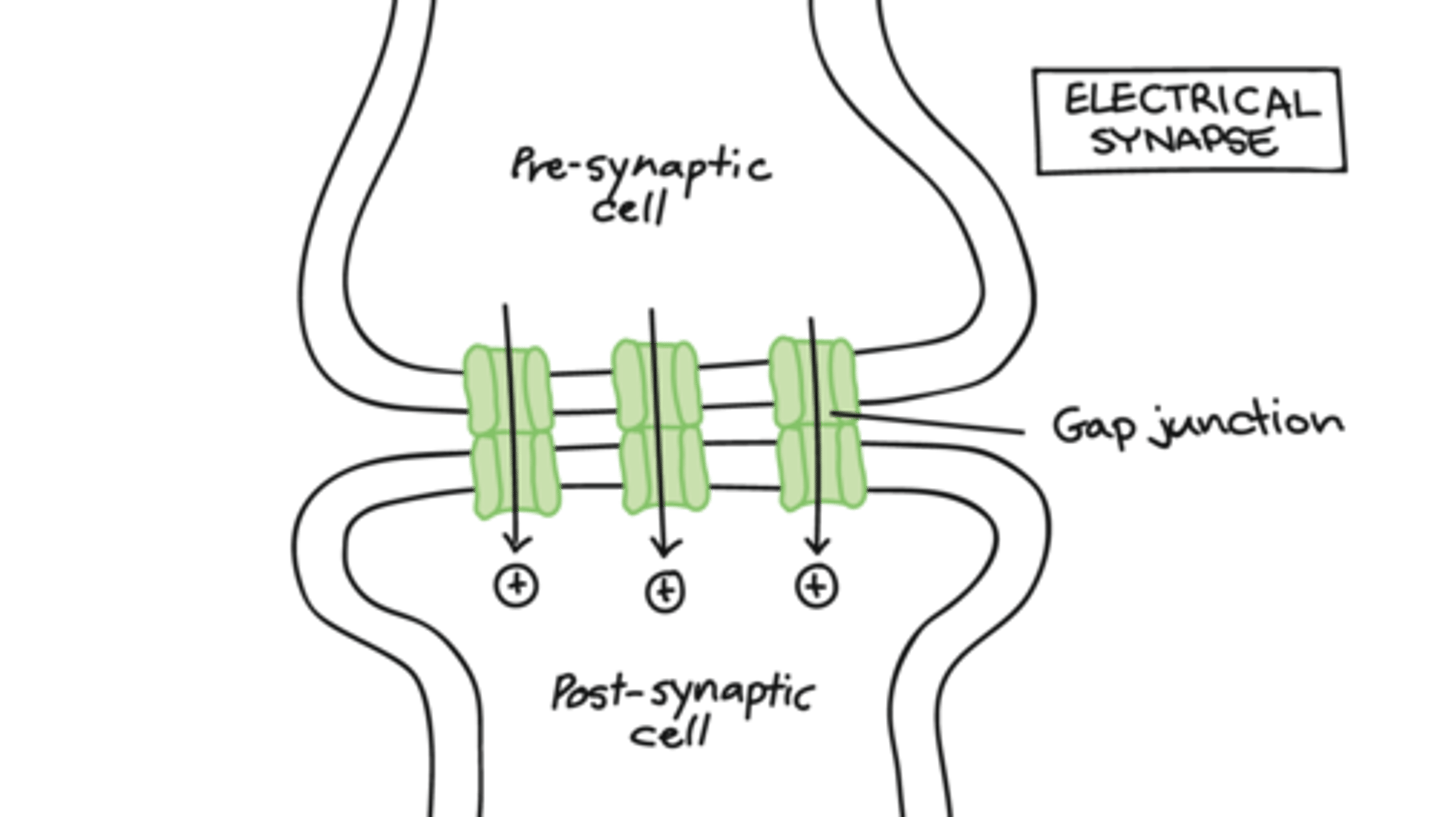
Which of the following describes a synapse that has a gap between its axon terminal and the membrane of the target cell?
(A) Potential
(B) Electrical
(C) Chemical
(D) Kinetic
(C) Chemical
A chemical synapse has a gap between it's axon terminal and the membrane of the target cell. The other type of synapse is Electrical, in which there is no gap, and the axon terminal physically connects to the membrane of the target cell.
The other answer choices, Potential & Kinetic, are not types of synapses.
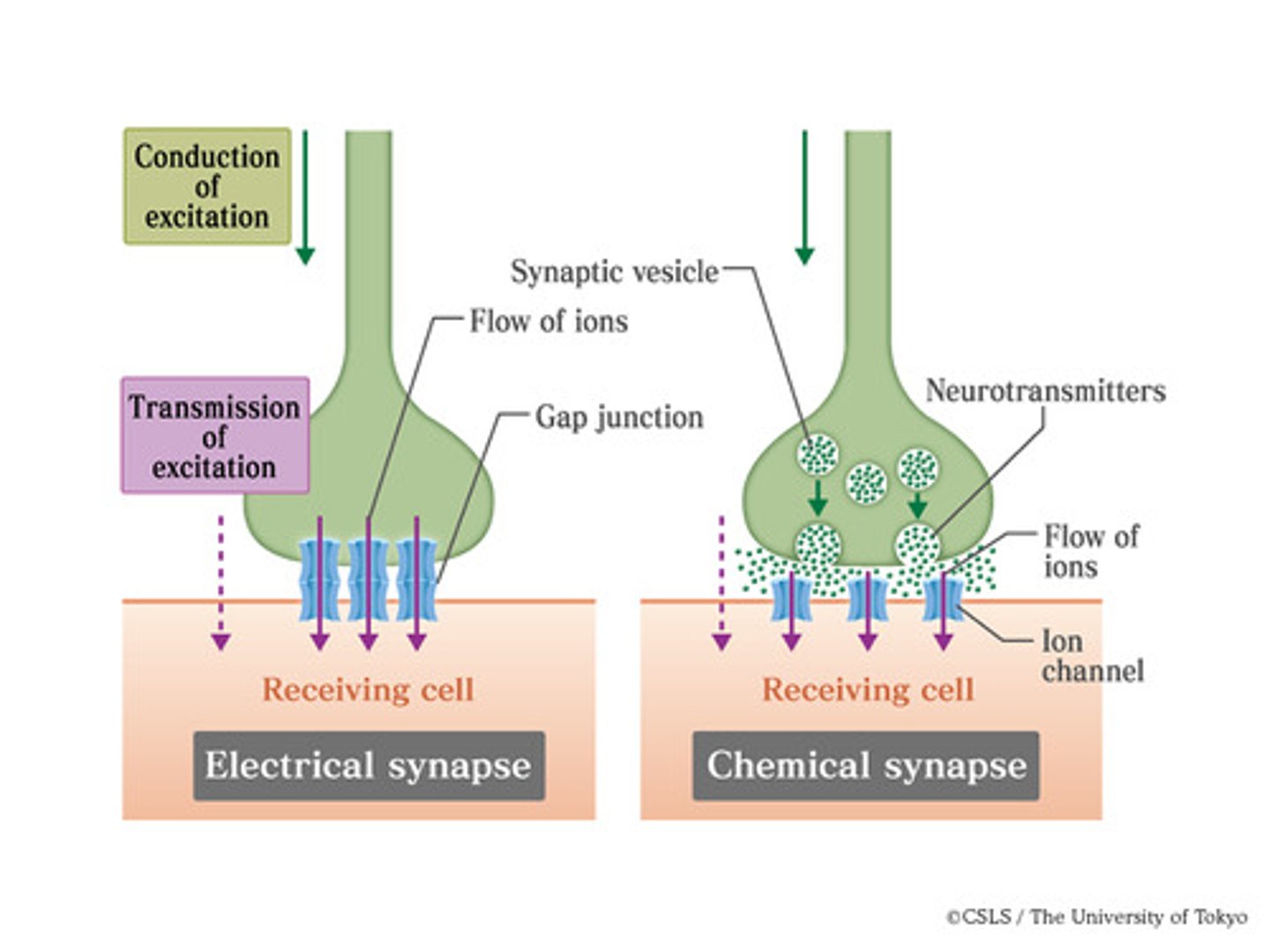
Draw a chemical synapse. Include the presynaptic membrane, postsynaptic membrane, synaptic vesicles, neurotransmitters, and receptors.

CRB Draw an electrical synapse, including its Gap Junctions.

CRB Fill in the blanks: ____________ Synapses are common in both smooth muscle and in cardiac muscle to coordinate contraction; ___________ Synapses are most often seen in the Nervous System.
(A) Electrical, Electrical
(B) Electrical, Chemical
(C) Chemical, Electrical
(D) Chemical, Chemical
(B) Electrical, Chemical
Electrical Synapses are common in both smooth muscle and in cardiac muscle to coordinate contraction; Chemical Synapses are most often seen in the Nervous System.
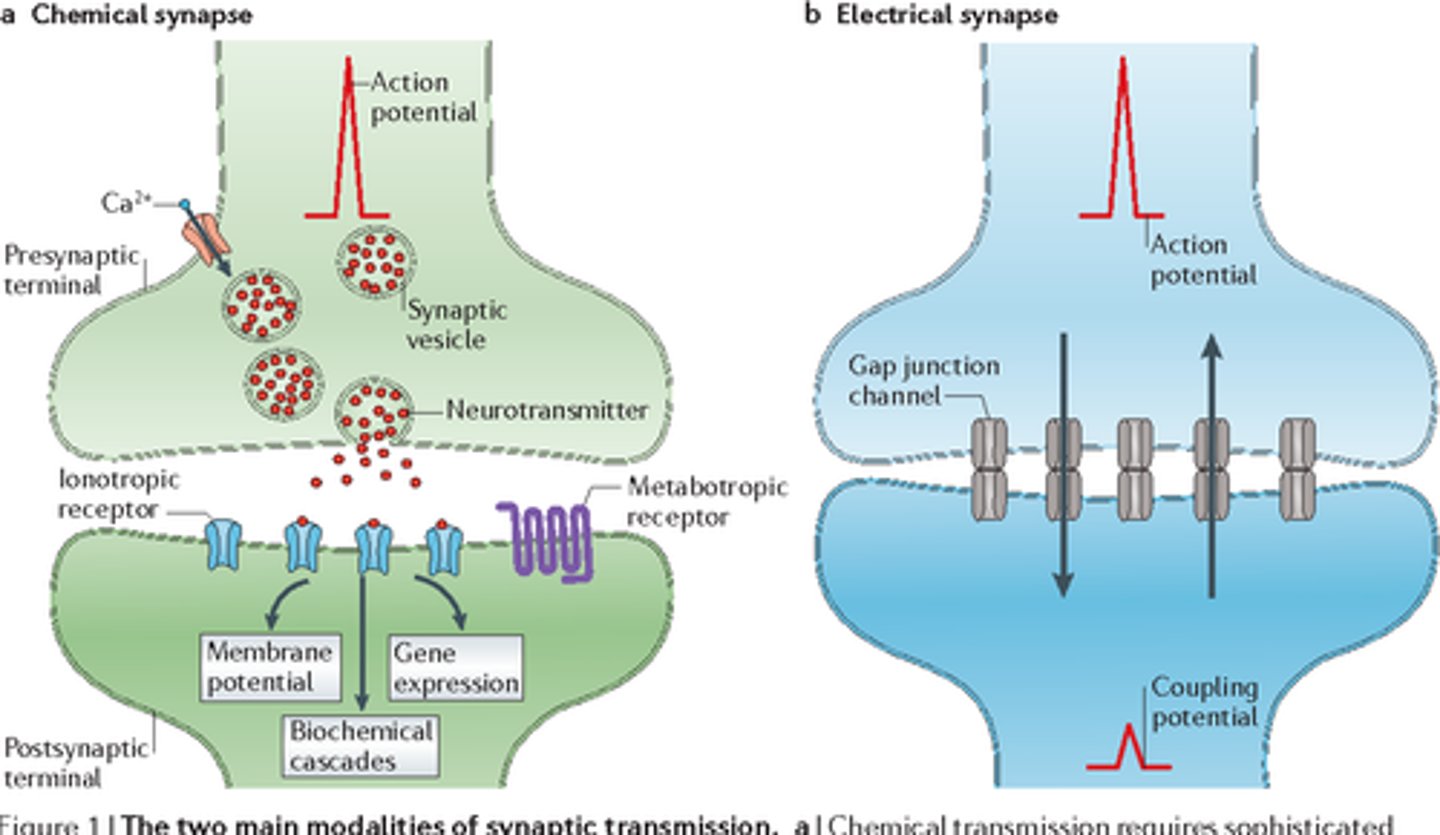
Which of the following voltage-gated channel is present at the axon terminal that aids in neurotransmitter release?
(A) Ca2+
(B) Ca+
(C) K+
(D) Na+
(A) Ca2+
Calcium voltage channels are present at the axon terminal. Remember, Calcium is a 2+ charge and not 1+.
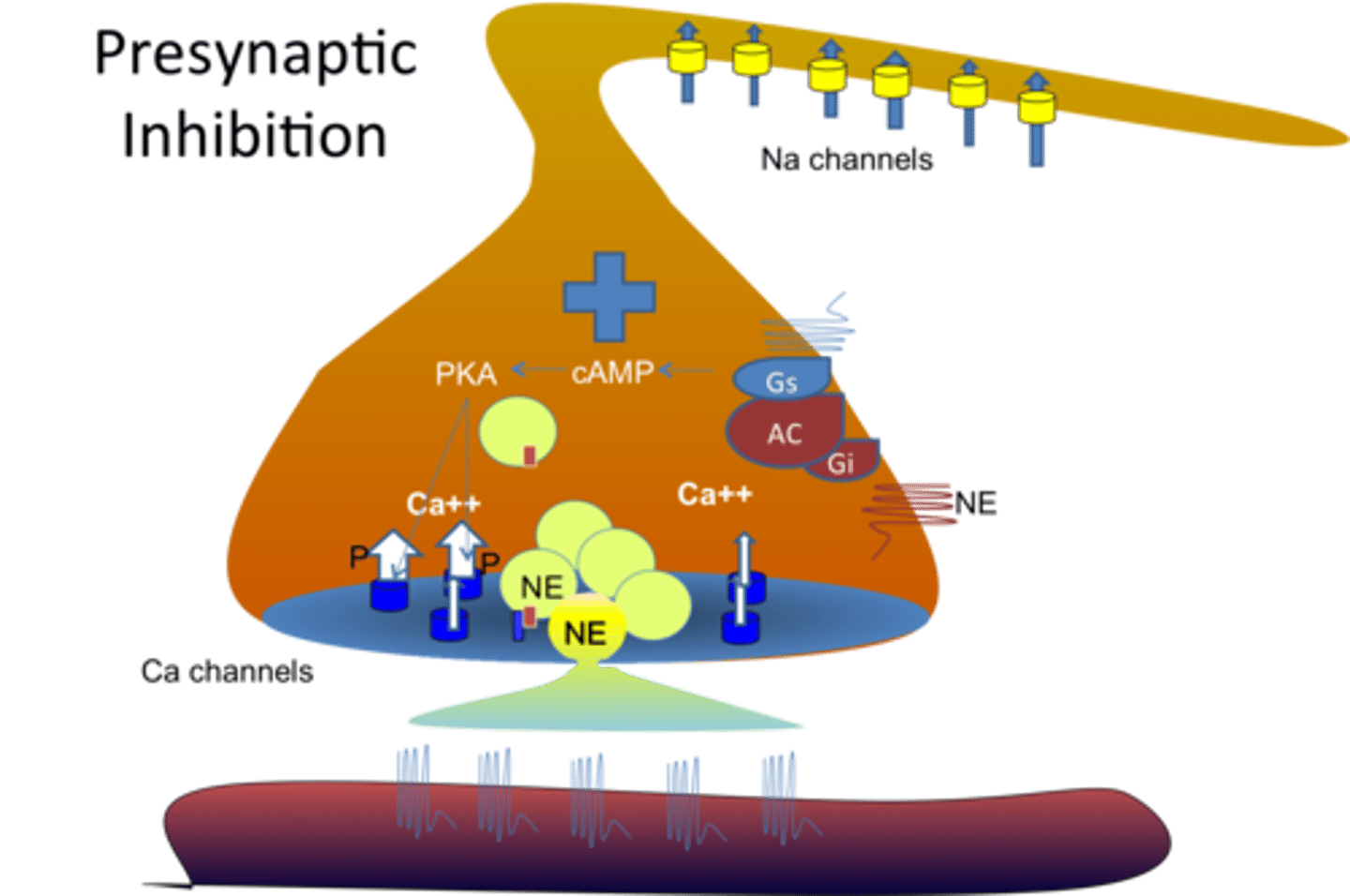
CRB True or false? The Calcium mechanisms that are used to trigger neurotransmitter release from vesicles can also be used for most Protein Hormones stored in vesicles.
True. The Calcium mechanisms that are used to trigger neurotransmitter release from vesicles can also be used for most Protein Hormones stored in vesicles.
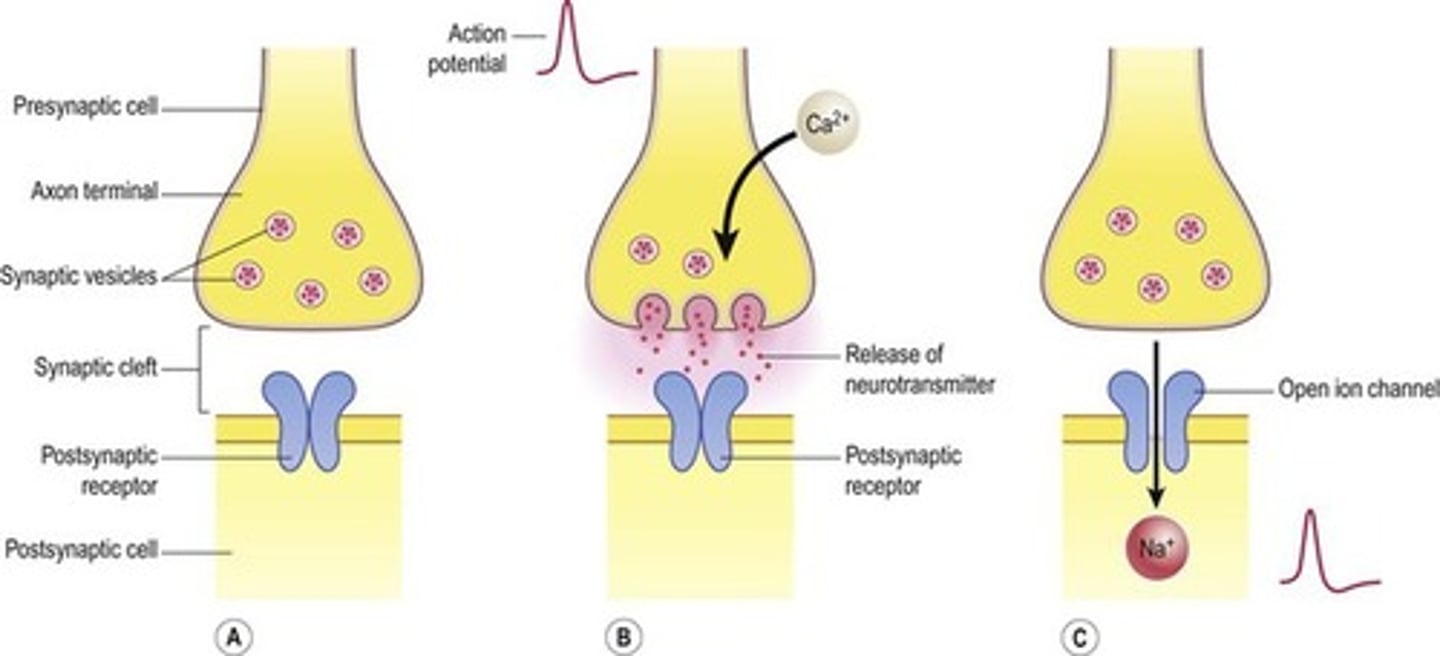
CRB There are certain types of cells which will not rely upon Calcium to trigger Vesicular Release, like the Chief Cells in the Parathyroid Gland that would release Parathyroid Hormone (which increases Calcium). Which molecule would you expect these cells to use to trigger Vesicular Release?
(A) K+
(B) Na+
(C) Cl-
(D) Mg2+
(D) Mg2+
The Chief Cells in the Parathyroid Gland use Magnesium cations to trigger vesicular release, because of its similar structure.
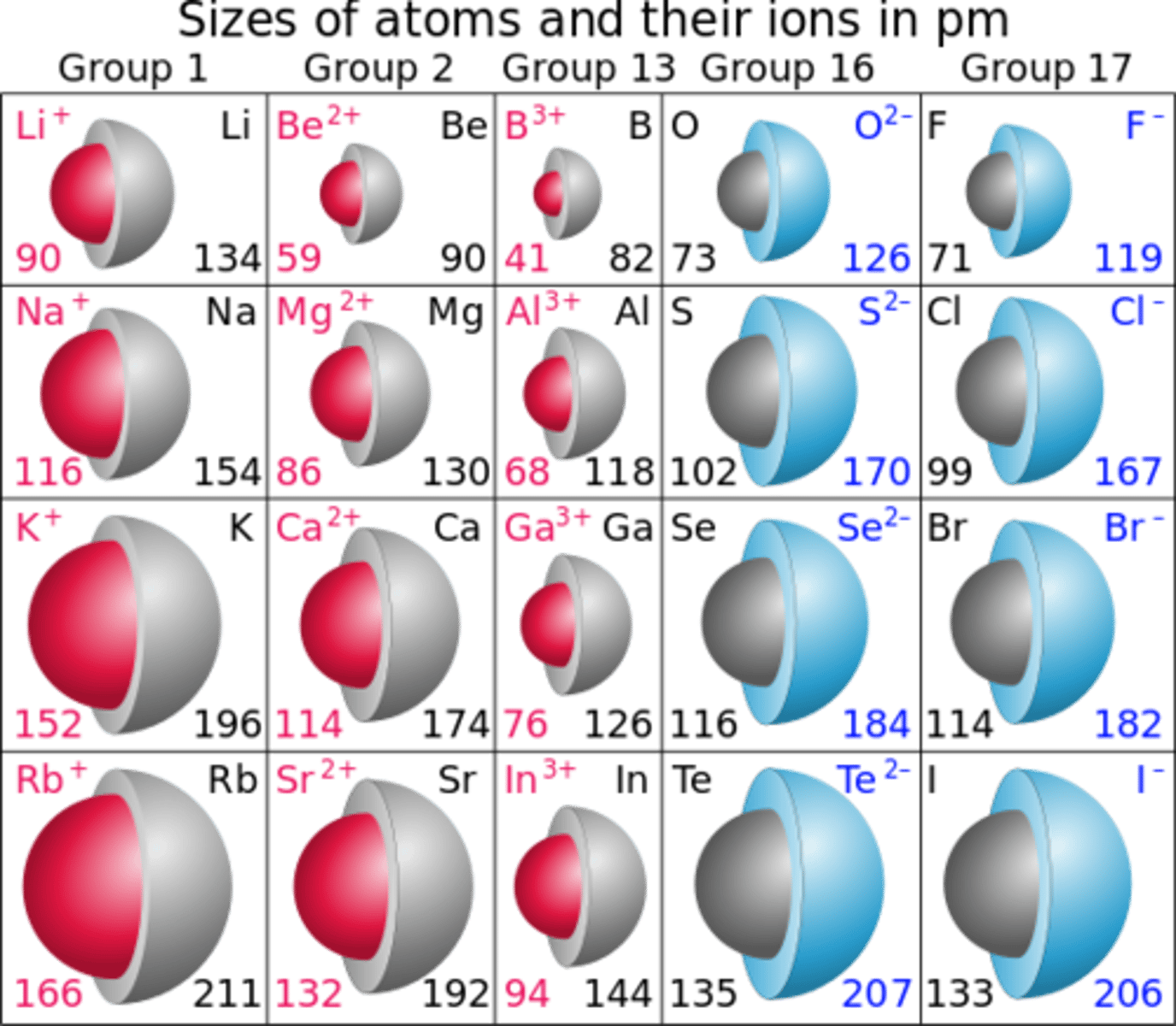
When an action potential comes down an axon and reaches the axon terminal, the action potential will change the membrane potential at the axon terminal and open voltage-gated Ca2+ channels. Will calcium flow into the membrane or out?
Calcium will flow INTO the membrane, since it is at a higher concentration outside than inside and the inside of the cell is oppositely charged (negatively charged) compared to the extracellular fluid.
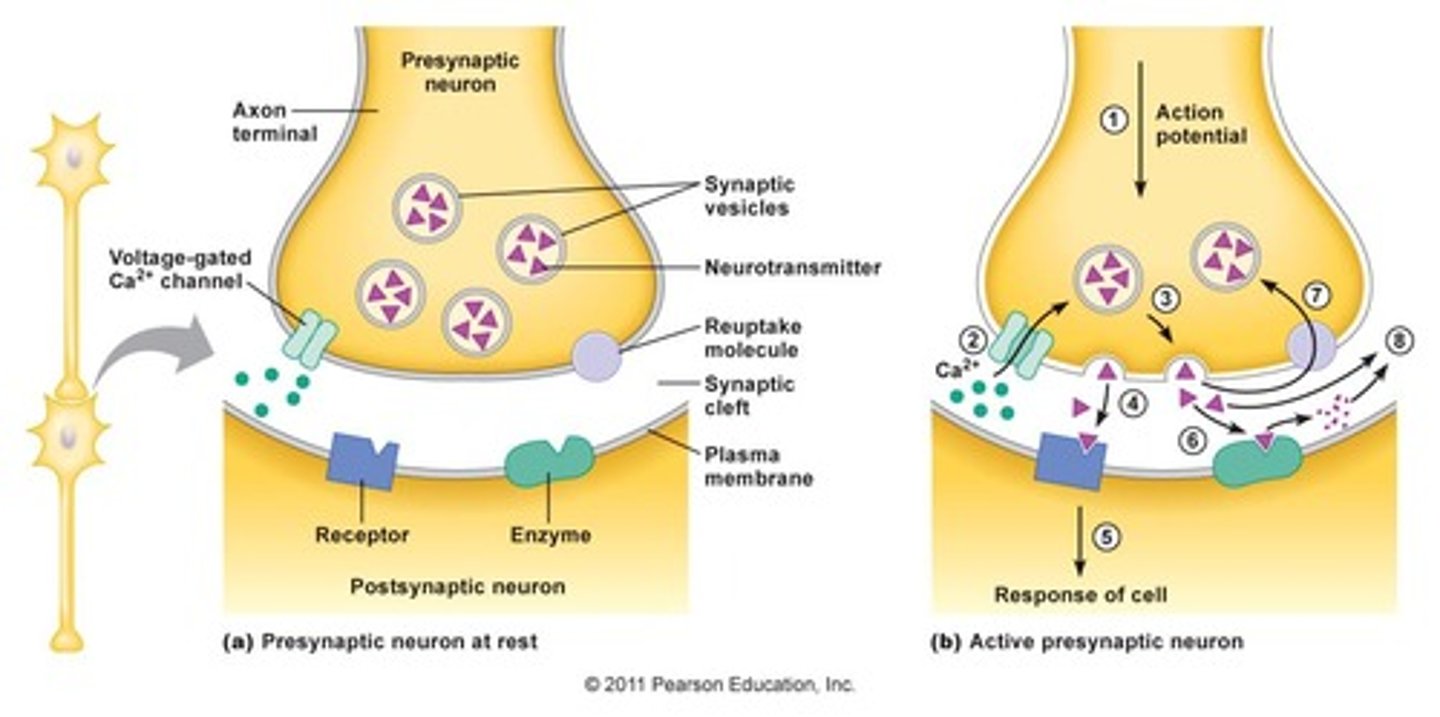
What is the role of Ca2+ in the release of neurotransmitters?
Ca2+ will signal to the synaptic vesicles to fuse with the pre-synaptic membrane, and release their neurotransmitters into the synapse.
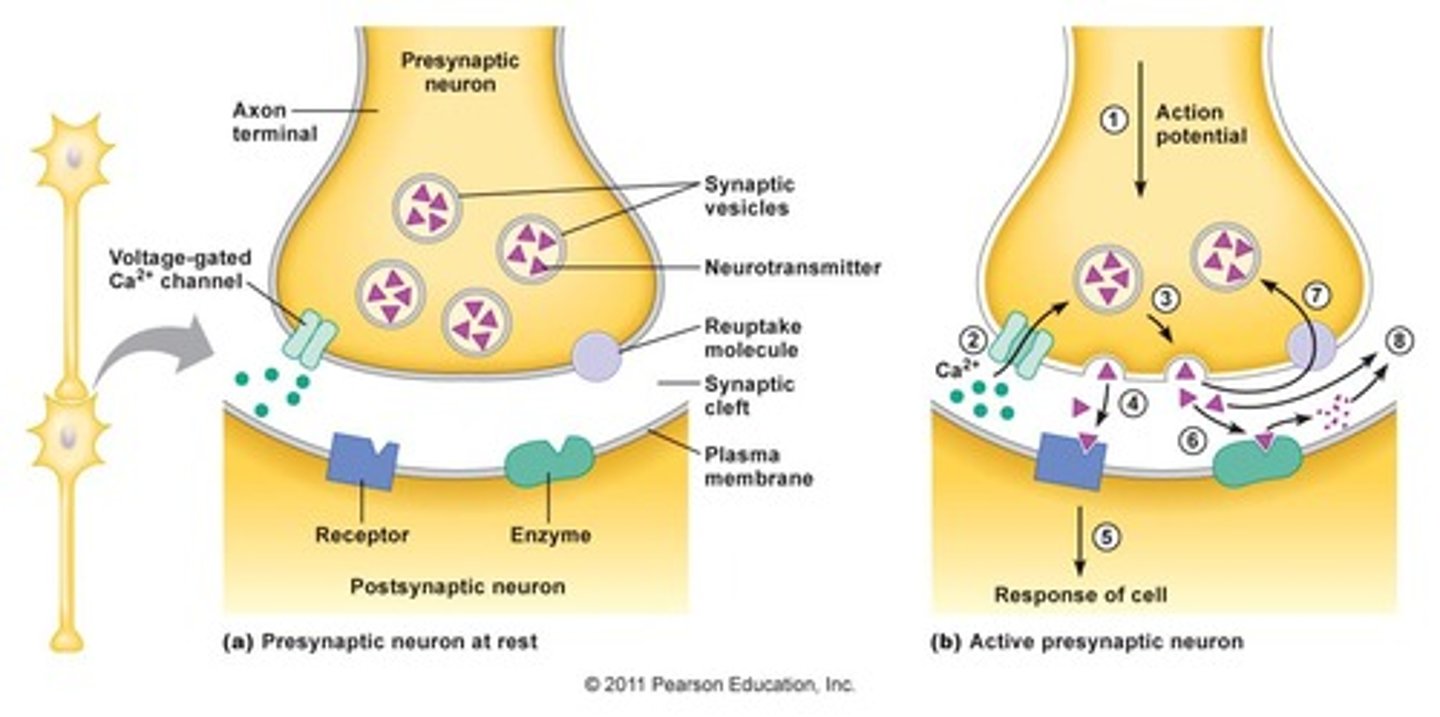
CRB If the neurotransmitter is released into the synaptic cleft, a space between both neurons, then why does it only have an effect on one of the neurons?
The Post-Synaptic Neuron has receptors for this Neurotransmitter, so it has a way to affect the cell! These receptors are not on the Pre-Synaptic Bouton of the axon, but would be found on that neuron's own dendrites.
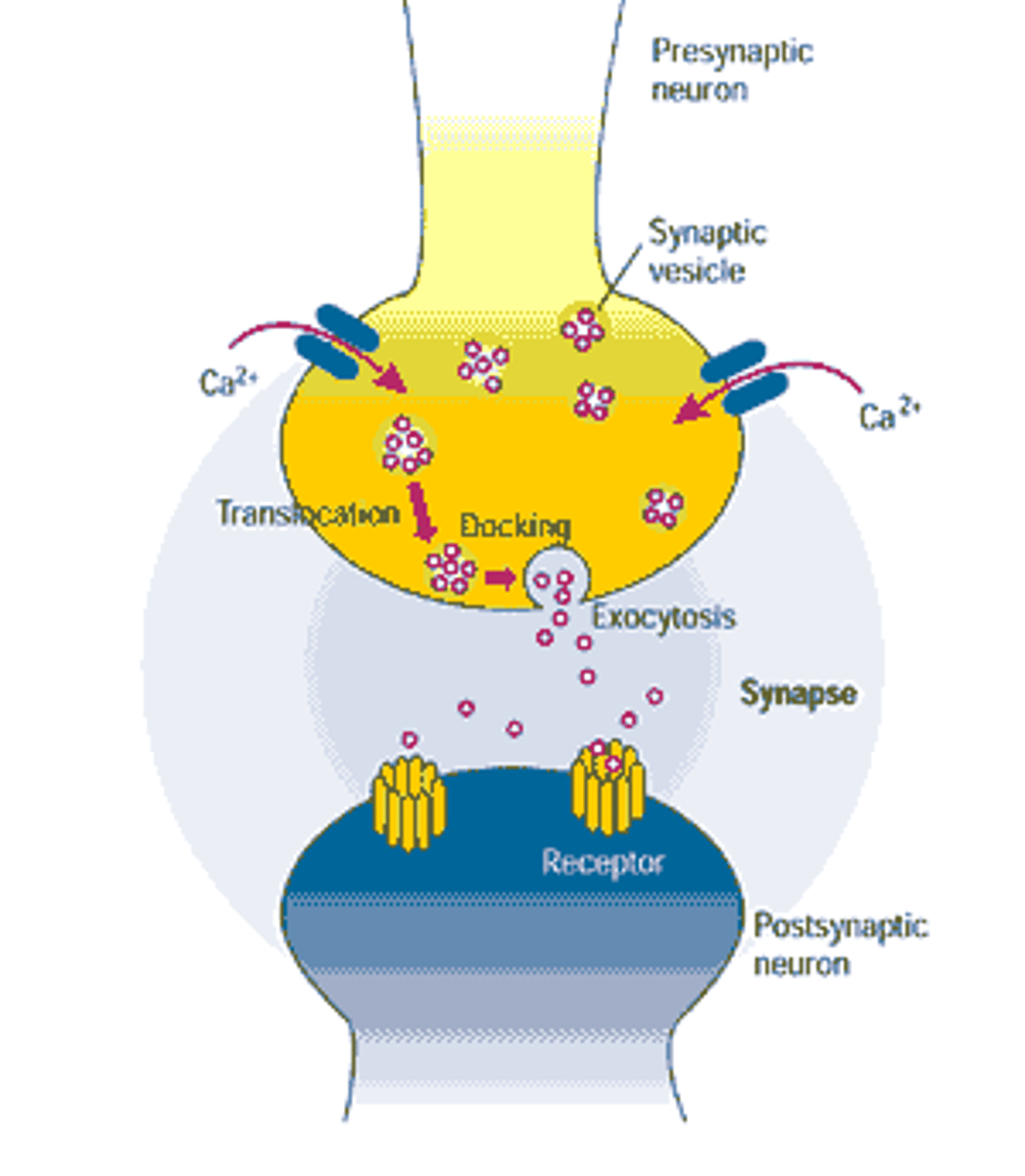
True or false? The amount of neurotransmitter released into the synaptic cleft is dependent on the intensity of the action potential that went down the axon.
False. The amount of neurotransmitter released into the synaptic cleft is dependent on the frequency of action potentials being fired down the axon of the neuron. Remember, action potentials are all-or-none signals that do not have varying strengths.
A higher action potential frequency will cause more openings of the calcium channels to open, more calcium will flow in, and the increased concentration of calcium will cause a greater amount of neurotransmitter release.
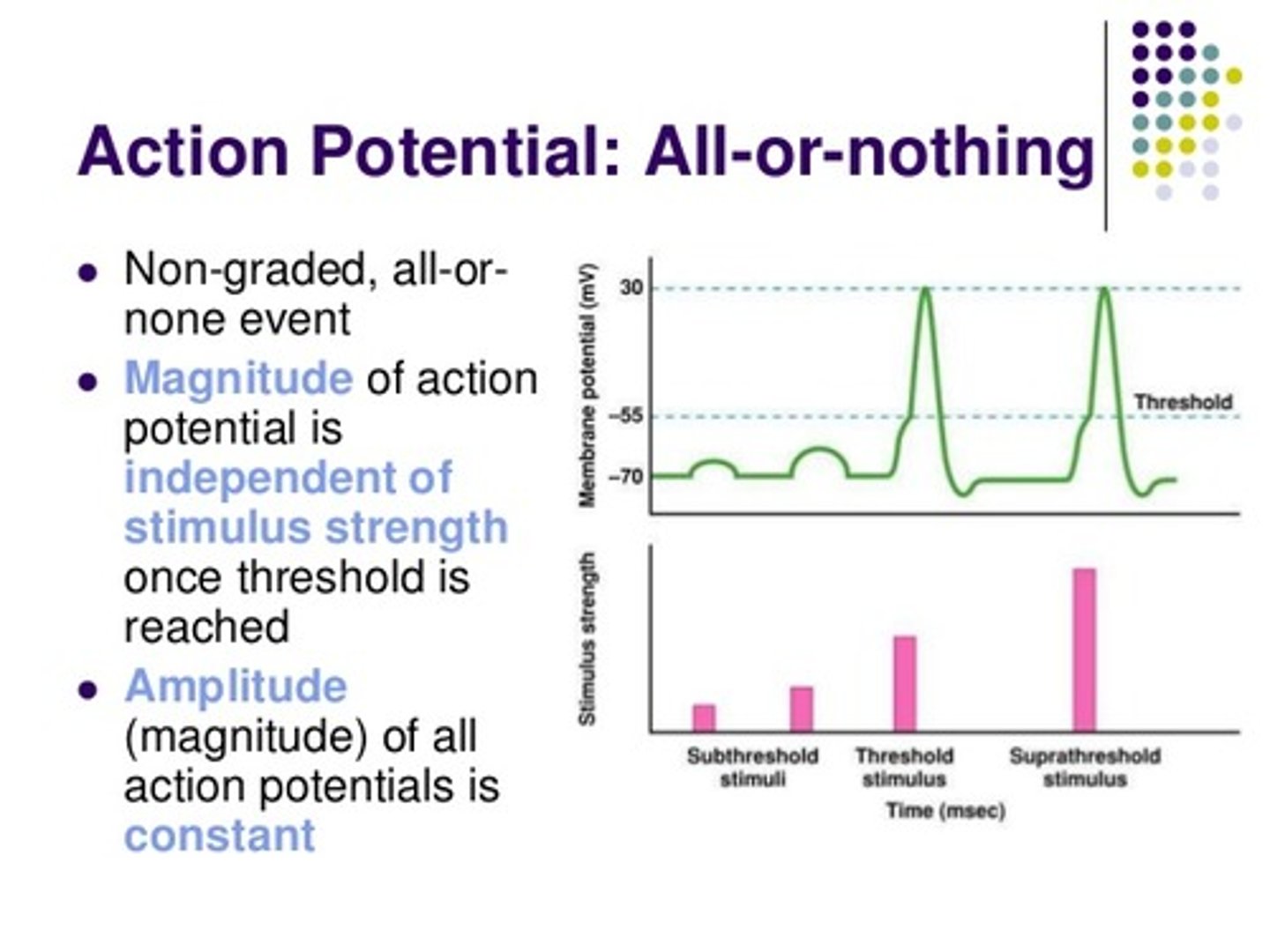
CRB Imagine that someone has a defect in Calcium pumps that made them non-functional, leaving Calcium inside the cell for extended periods of time. Which of the following symptoms would you expect?
I. Increased Neurotransmitter release
II. Increased Protein Hormone Secretion
III. Increased Muscle Contractions (initially)
(A) I only
(B) I and II only
(C) I and III only
(D) I, II and III
(D) I, II and III
Each of the following are symptoms to expect if Calcium could not be cleared from cells:
I. Increased Neurotransmitter release
II. Increased Protein Hormone Secretion
III. Increased Muscle Contractions (initially)
Which of the following correctly matchs the type of amino acid neurotransmitter with its function.
I. Glutamate - Excitatory
II. GABA - Inhibitory
III. Glycine - Excitatory
(A) I only
(B) II only
(C) II and III only
(D) I and II only
(D) I and II only
While all three amino acids are neurotransmitters, only I and II describe them correctly with their function. Glutamate is mostly excitatory. GABA and Glycine are mostly inhibitory.
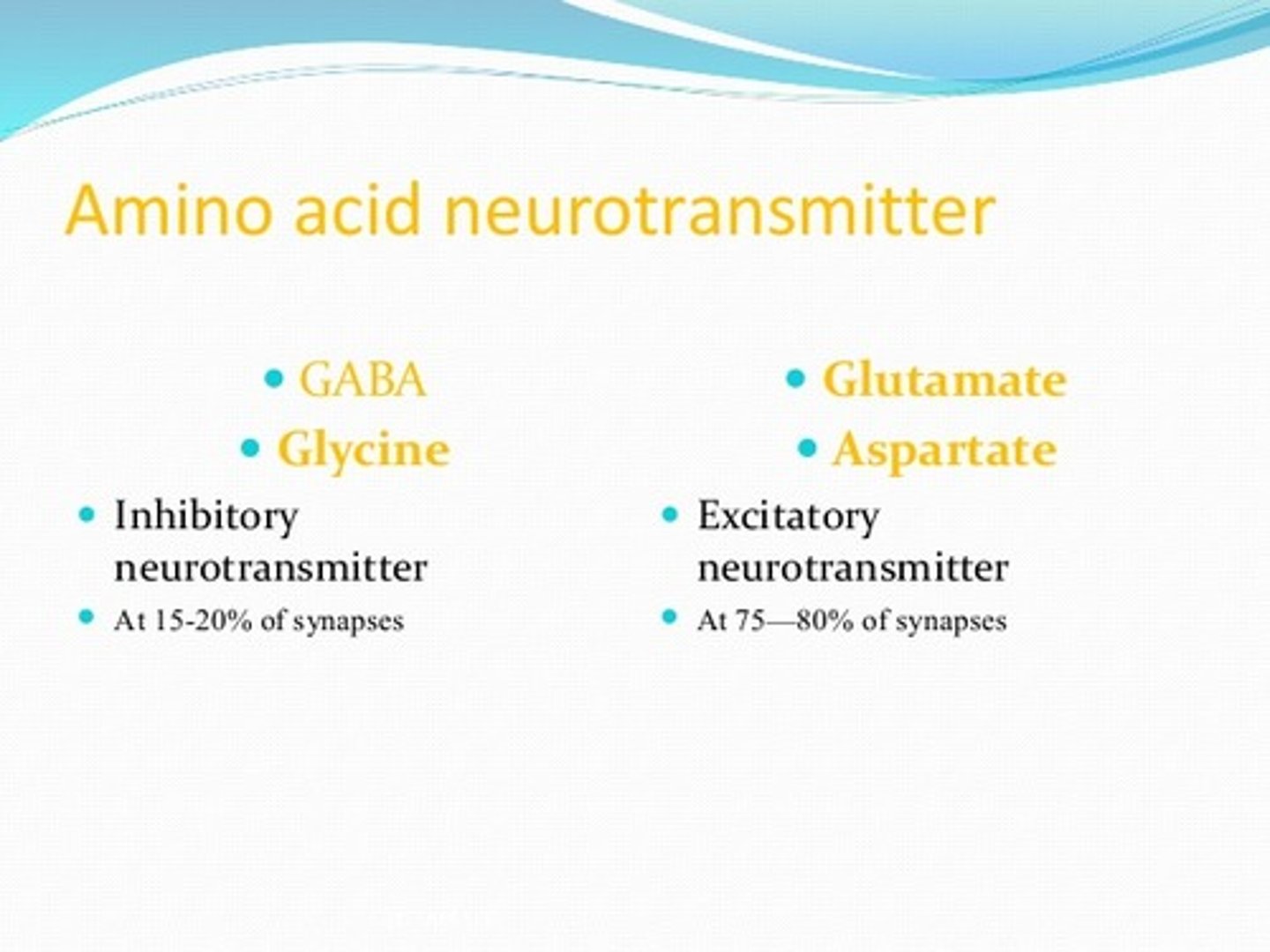
CRB You have just discovered a new neurotransmitter, and you want to see what it does! After many blocking experiments, you see that this neurotransmitter specifically allows Chlorine to enter the neuron. Would this be an Excitatory or Inhibitory Neurotransmitter?
Because allowing Chlorine to enter the neuron will decrease the membrane potential, this would be an Inhibitory Neurotransmitter. This one would function a lot like GABA!
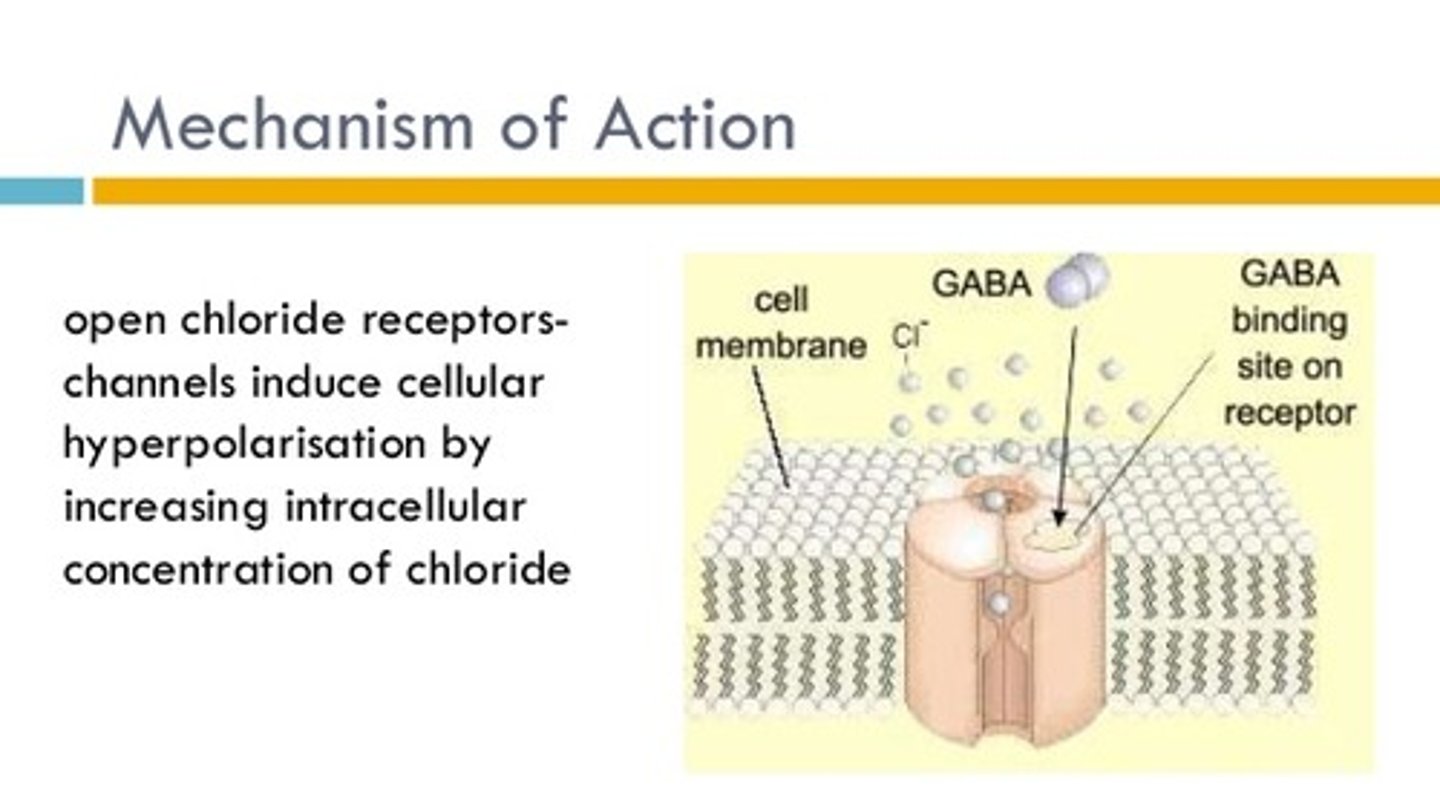
The monoamine class of neurotransmitters play a role in attention, cognition, and emotion. Which of the following is NOT an example of a monoamine neurotransmitter?
(A) Serotonin
(B) Glycine
(C) Histamine
(D) Epinephrine/ Norepinephrine
(B) Glycine
While glycine is a type of amino acid neurotransmitter, is not a type of monoamine neurotransmitter. Dopamine is another monoamine neurotransmitter.
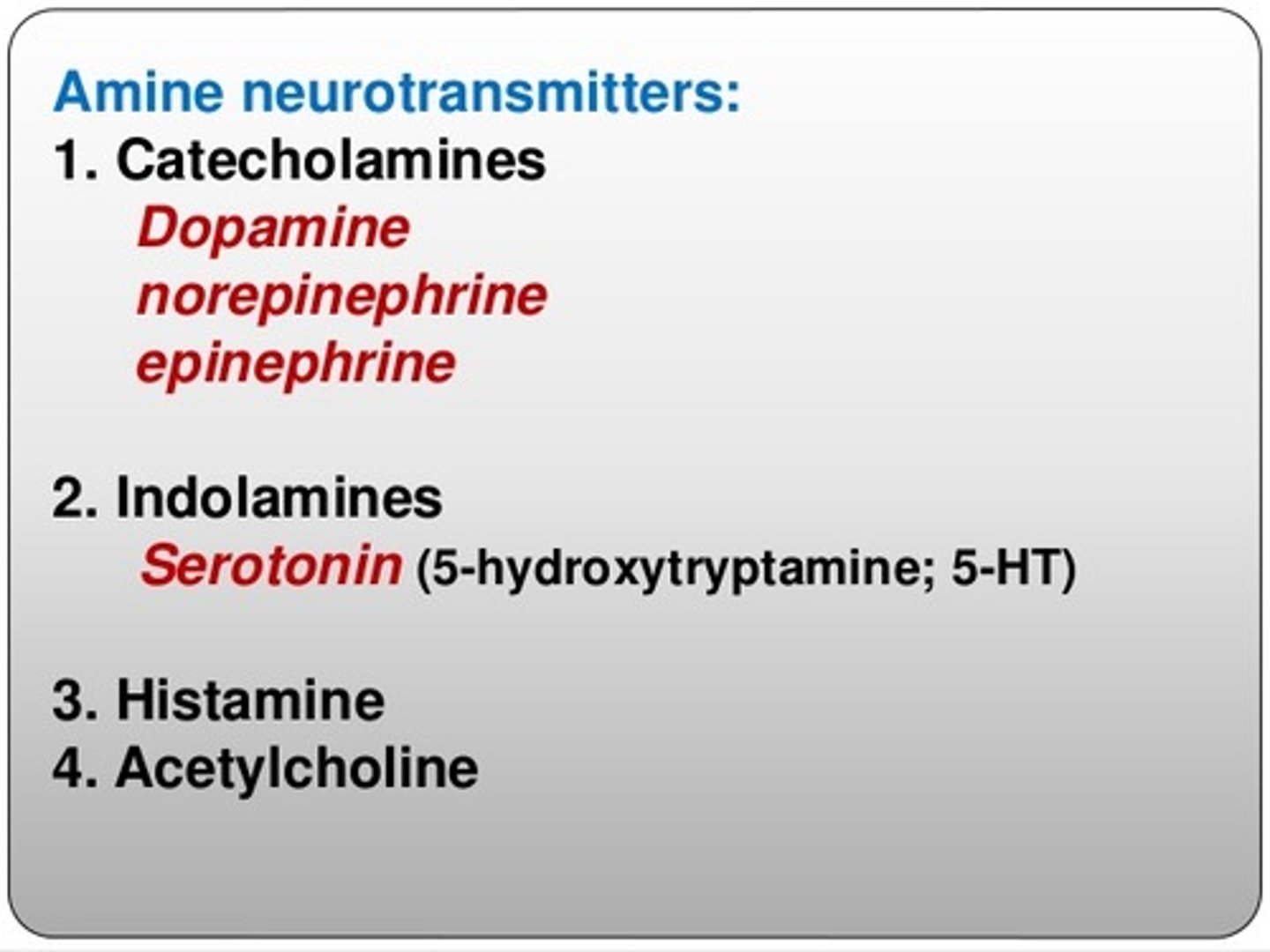
Compare Catecholamines to Monoamines.
Catecholamines are a subtype of Monoamines that have a Catechol group (benzene ring with two hydroxy groups).

CRB Which of the following is NOT one of the three major Catecholamines?
(A) Serotonin
(B) Epinephrine
(C) Noradrenaline
(D) Dopamine
(A) Serotonin
The three major Catecholamines are:
I. Epinephrine/Adrenaline
II. Norepinephrine/Noradrenaline
III. Dopamine
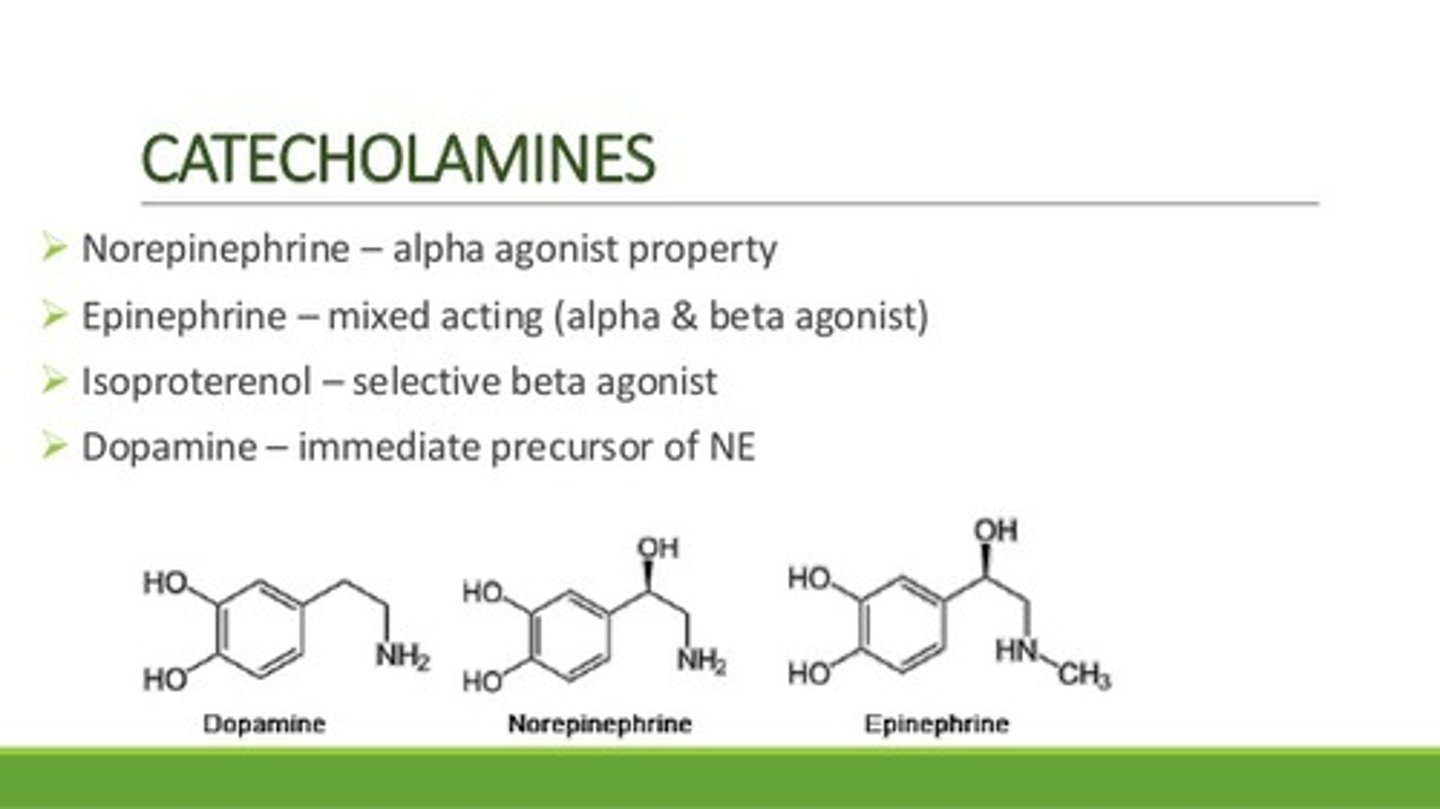
CRB True or false? Each of the three major Catecholamines play key roles in experiencing emotions.
True. Each of the three major Catecholamines play key roles in experiencing emotions.

CRB Compare the effects that Epinephrine and Norepinephrine have.
Both of these catecholamines play a key role in controlling alertness and wakefulness.
Norepinephrine is known for having local effects as a neurotransmitter, whereas Epinephrine is more known for acting as a hormone and being secreted by the Adrenal Medulla.
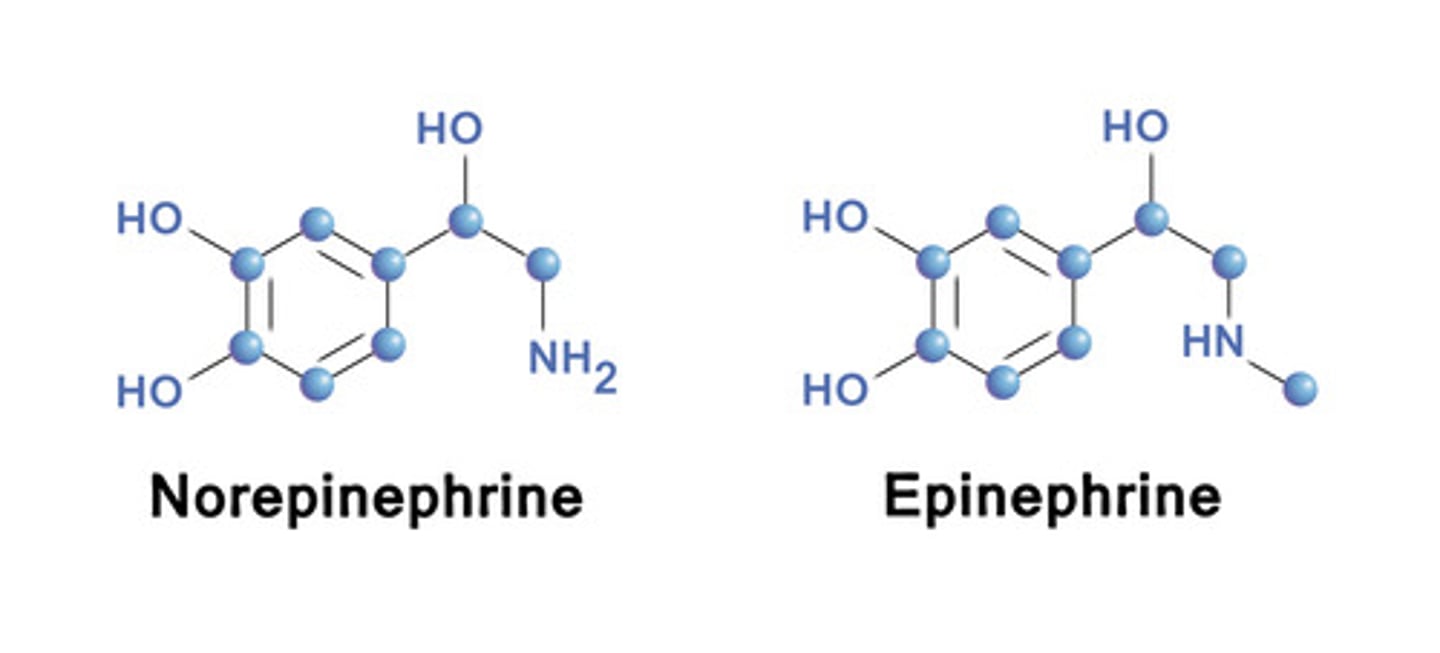
CRB Fill in the blanks: Low levels of ________________ are associated with depression; high levels are associated with ____________________.
(A) Epinephrine, bipolar disorder
(B) Norepinephrine, bipolar disorder
(C) Epinephrine, anxiety and mania
(D) Norepinephrine, anxiety and mania
(D) Norepinephrine, anxiety and mania
Low levels of Norepinephrine are associated with depression; high levels are associated with Anxiety and Mania.
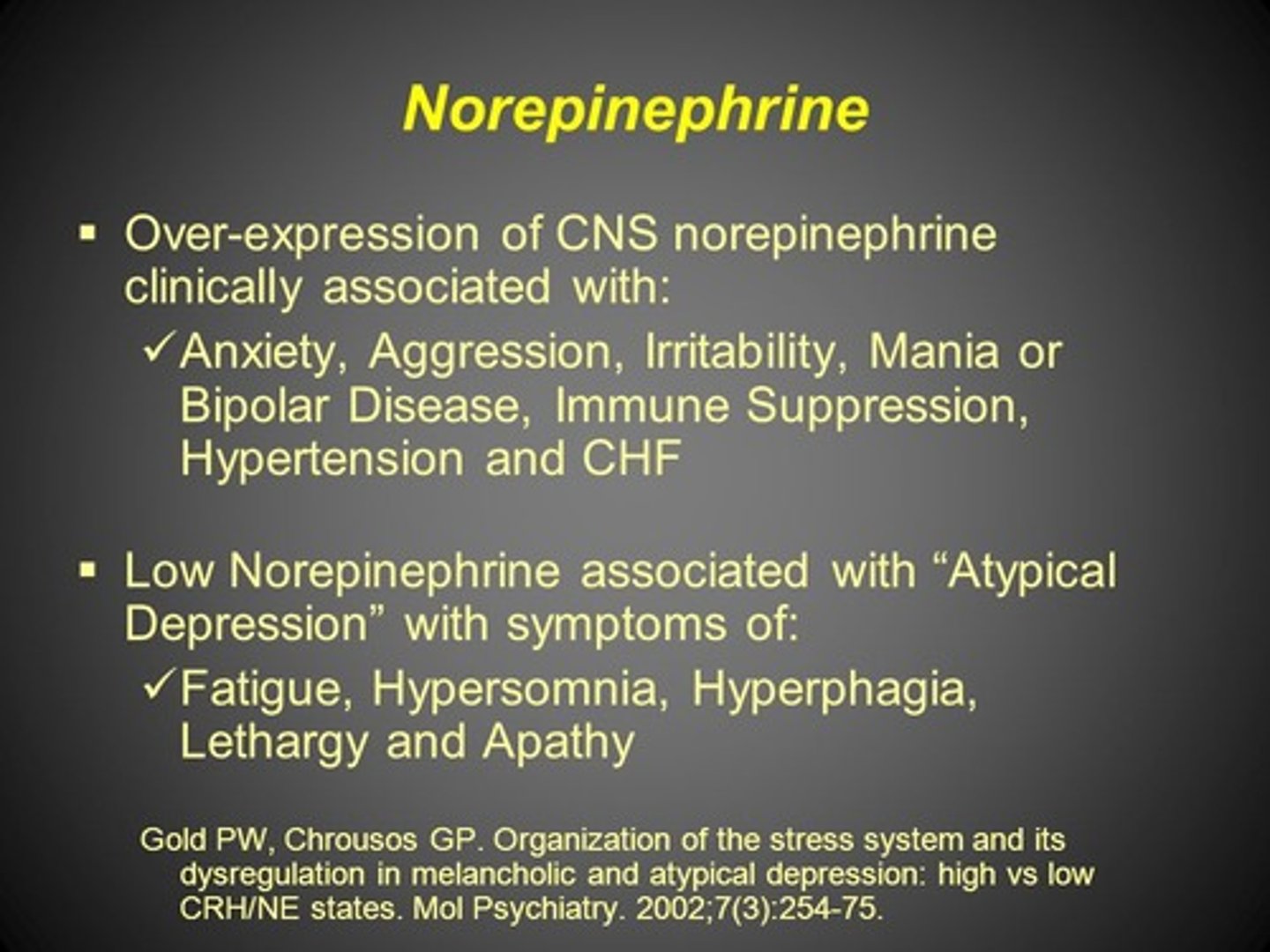
CRB Which of the following diseases has altered dopamine levels been associated with?
I. Schizophrenia
II. Bipolar Disorder
III. Parkinson's Disease
(A) III only
(B) I and II only
(C) I and III only
(D) II and III only
(C) I and III only
Elevated Dopamine (or increased sensitivity to dopamine) has been theorized to cause symptoms of Schizophrenia.
Decrease Dopamine due to loss of dopaminergic neurons in the basal ganglia is associated with Parkinson's Disease.
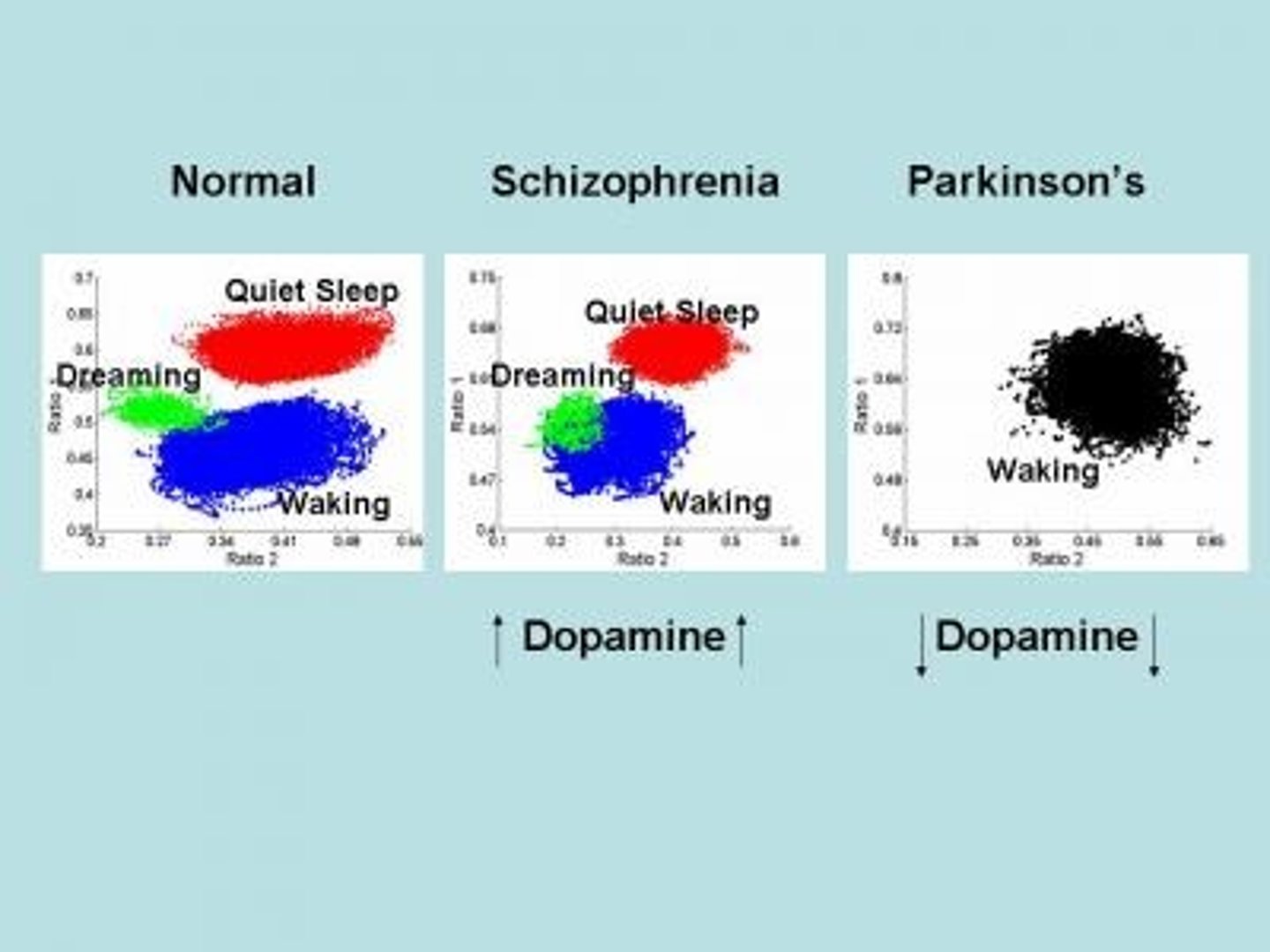
Describe the key structural characteristics of monoamines.
Monoamines have a single amine group, aromatic group, and a two carbon link between the two.
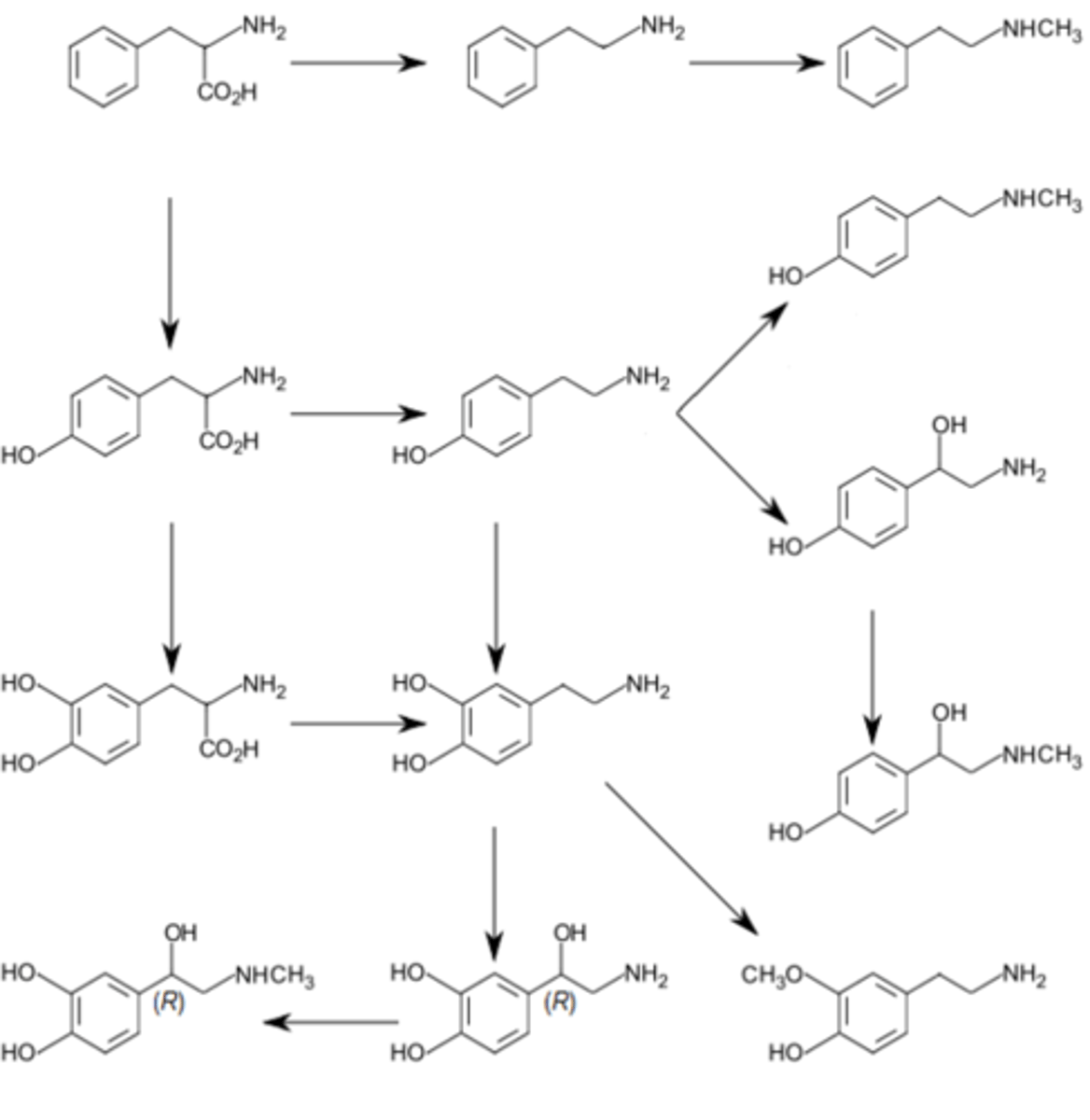
Which of the following is NOT a neurotransmitter?
(A) Glycine
(B) Lysine
(C) Acetylcholine
(D) Endorphin
(B) Lysine
While there are amino acids which do function as neurotransmitters, Lysine is not one of them. Other neurotransmitters are listed as follows:
- Glutamate
- GABA
- Serotonin
- Histamine
- Dopamine
- Epinephrine/ norepinephrine
- Opioids
- Acetylcholine

Describe how each of the following may help clear out neurotransmitters from the synaptic cleft.
1. Re-uptake Pumps
2. Diffusion
3. Enzymes
1. Re-uptake Pumps. These may be located on the pre-synaptic neuron and astrocyte end feet. They will actively pump neurotransmitters out of the synapse.
2. Diffusion. Neurotransmitters may simply float out and away from the synapse.
3. Enzymes. Some enzymes actively break down neurotransmitters in the synapse.
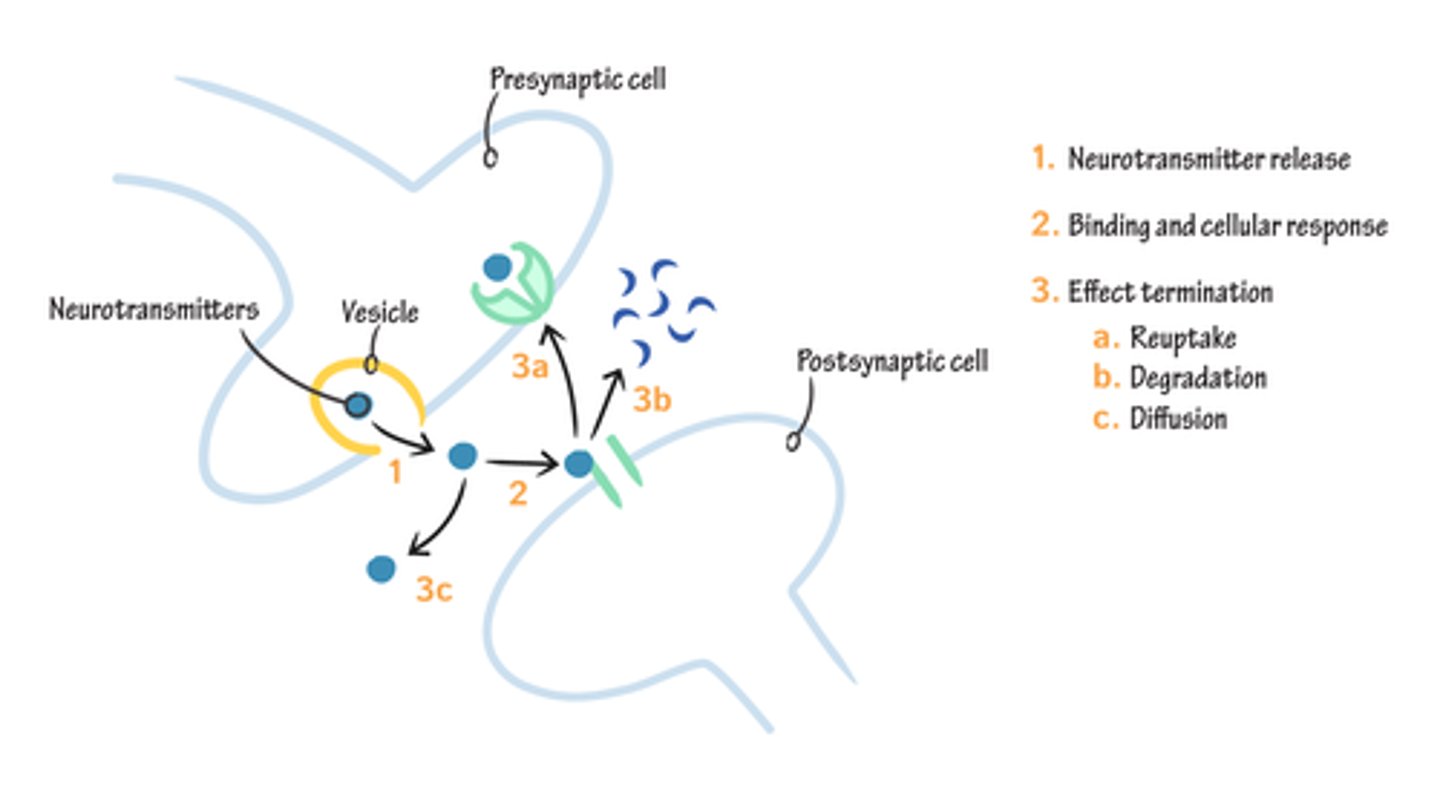
Compare Potentiation with Depression Neuroplasticity.
Potentiation is a change in neurons that results in stronger signal transmission.
Depression is a change in neurons that results in weaker signal transmission.

Compare Synaptic with Structural Neuroplasticity.
Synaptic Neuroplasticity is a strengthening or weakening of signal transmission due to an increase or decrease in receptors. These changes may happen over short or long periods of time.
Structural Neuroplasticity is a strengthening or weakening of signal transmission due to an increase or decrease in the number of axon terminals and dendrites. These changes typically occur over a long period of time.
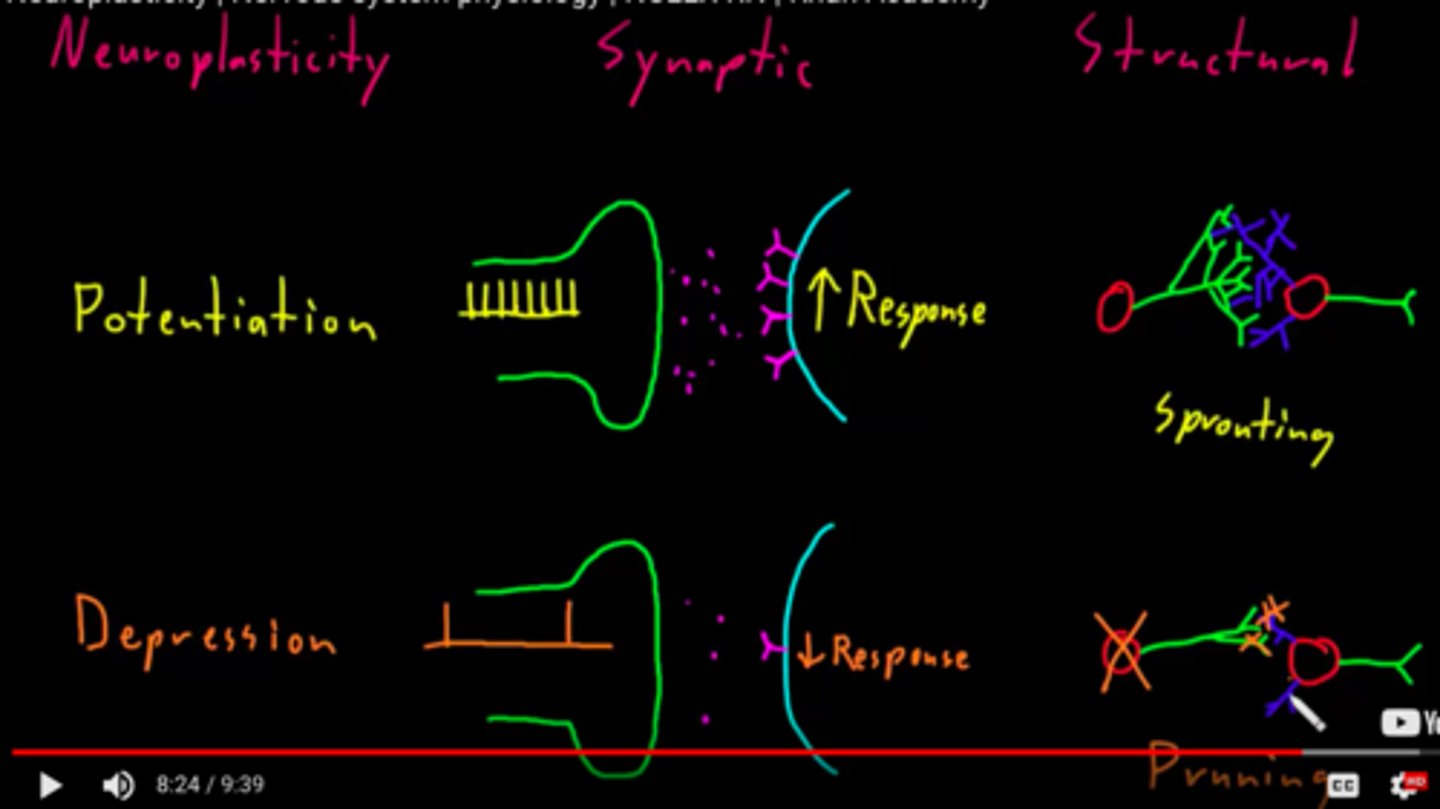
Compare Sprouting and Pruning.
Sprouting is long-term potentiation caused by an increased number of axon terminals and/or dendrites.
Pruning is depression caused by a decreased number of axon terminals and/or dendrites.

Alyssa is a trained science teacher, but started her own company in fashion merchandising and has been in the fashion industry for over 20 years without keeping up to date with science at all. Her son asks her a simple science question about protons and electrons, but she doesn't even know what those terms mean anymore. Is this an example of neural pruning or sprouting?
This scenario describes pruning. When there is a decreased firing of action potentials, there is a decreased response which causes the axon and dendritic branches to lessen. Sometimes even whole neurons can be removed.
